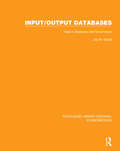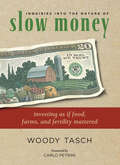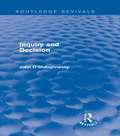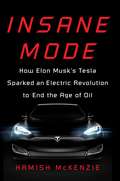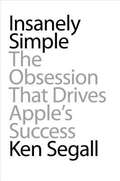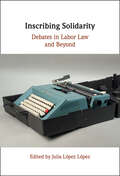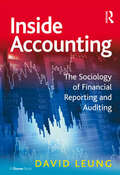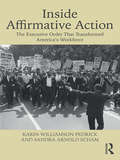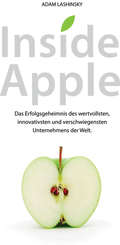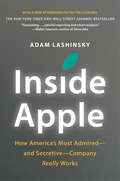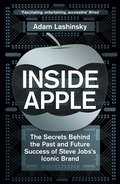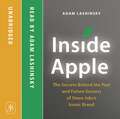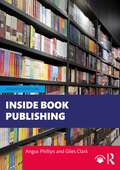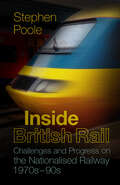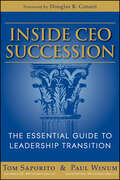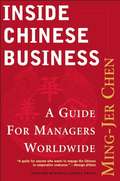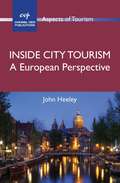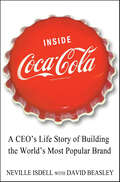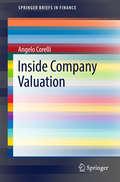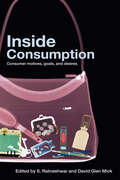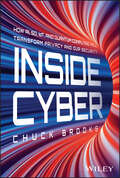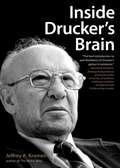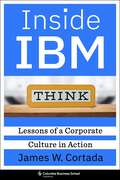- Table View
- List View
Input/Output Databases: Uses in Business and Government (Routledge Library Editions: Econometrics #7)
by Jay M. GouldOriginally published in 1979. An Input/output database is an information system carrying current data on the intermediate consumption of any product or service by all the specified major firms that consume it. This book begins with a survey of how the interrelationships of an economic system can be represented in a two-dimensional model which traces the output of each economic sector to all other sectors. It talks about how the use of such databases to identify major buyers and sellers can illuminate problems of economic policy at the national, regional, and corporate level and aid in analyzing factors affecting the control of inflation, energy use, transportation, and environmental pollution. The book discusses how advances in database technology, have brought to the fore such issues as the right to individual privacy, corporate secrecy, the public’s right of access to stored data, and the use of such information for national planning in a free-enterprise society.
Inquiries into the Nature of Slow Money: Investing as if Food, Farms, and Fertility Mattered
by Woody TaschCould there ever be an alternative stock exchange dedicated to slow, small, and local? Could a million American families get their food from CSAs? What if you had to invest 50 percent of your assets within 50 miles of where you live?Such questions—at the heart of slow money—represent the first steps on our path to a new economy.Inquiries into the Nature of Slow Money presents an essential new strategy for investing in local food systems and introduces a group of fiduciary activists who are exploring what should come after industrial finance and industrial agriculture. Theirs is a vision for investing that puts soil fertility into return-on-investment calculations and serves people and place as much at it serves industry sectors and markets.Leading the charge is Woody Tasch-whose decades of work as a venture capitalist, foundation treasurer, and entrepreneur now shed new light on a truer, more beautiful, more prudent kind of fiduciary responsibility. He offers an alternative vision to the dusty old industrial concepts of the nineteenth and twentieth centuries when dollars, and the businesses they financed, lost their connection to place; slow money, on the other hand, is firmly rooted in the new economic, social, and environmental realities of the 21st century.Inquiries into the Nature of Slow Money is a call to action for designing capital markets built around not extraction and consumption but preservation and restoration. Is it a movement or is it an investment strategy? Yes.
Inquiry and Decision (Routledge Revivals)
by John O'ShaughnessyFirst published in 1972, this book combines concepts from the philosophy of science and statistics with social science techniques to form a methodological text for all those engaged in the social sciences and in management. It details the processes of inquiry – namely description, explanation, evaluation and prediction – and shows the role they play in prescriptive decision-making. It is argued that an understanding of these processes lies behind successful inquiry and is an aid to effective decision-making. Broad in scope, this reissue will help the decision-maker avoid some of the errors that can arise in moving from a set of stated goals to the selection of the course of action that will achieve these goals. It will appeal to all those engaged in inquiry in the fields of sociology, psychology, political science, and business and management studies, as well as the manager in both the public and private sector.
Insane Mode: How Elon Musk's Tesla Sparked an Electric Revolution to End the Age of Oil
by Hamish McKenzie“You’ll tell me if it ever starts getting genuinely insane, right?” --Elon Musk, TED interview Hamish McKenzie tells how a Silicon Valley start-up's wild dream came true. Tesla is a car company that stood up against not only the might of the government-backed Detroit car manufacturers but also the massive power of Big Oil and its benefactors, the infamous Koch brothers. The award-winning Tesla Model 3, a premium mass-market electric car that went on sale in 2018, has reconfigured the popular perception of Tesla and continues to transform the public's relationship with motor vehicles--much like Ford's Model T did nearly a century ago. At the same time, company CEO Elon Musk courts controversy and spars with critics through his Twitter account, just as Tesla's ever-increasing debt teeters on junk bond status. . . . As McKenzie's rigorously reported account shows, Tesla has triggered frenzied competition from newcomers and traditional automakers alike, but it retains an edge because of its expansive infrastructure and the stupendous battery factory it built in the Nevada desert. The popularity of electric cars is growing around the world, especially in China, and McKenzie interviews little-known titans who have the money and the market access to power a global electric car revolution quickly and decisively."Insane Mode" started off as a feature on the dual-motor Tesla Model S, which gave the car Ferrari-like acceleration, but it's also the perfect description of the operating cycle of a company that has sworn it won't rest until every car on the road is electric. Here is a story about the very best kind of American ingenuity and its history-making potential. Buckle up!
Insanely Simple: The Obsession That Drives Apple's Success
by Ken SegallSimplicity isn't just a design principle at Apple--it's a value that permeates every level of the organization. It's what helped Apple recover from near death in 1997 to become the most valuable company on earth in 2012. As ad agency creative director, Ken Segall played a key role in Apple's resurrection, helping to create such critical marketing campaigns as "Think Different" and naming the iMac. This book makes you a fly on the wall inside a conference room with Steve Jobs, and on the receiving end of his midnight phone calls. You'll understand how his obsession with Simplicity helped Apple perform better and faster, sometimes saving millions in the process. Segall brings Apple's quest for Simplicity to life using fascinating (and previously untold) stories from behind the scenes. Through his insight and wit, you'll discover how companies that leverage this power can stand out from competitors--and individuals who master it can become critical assets to their organizations.
Inscribing Solidarity: Debates in Labor Law and Beyond
by Julia López LópezMany governments, large institutions, and collective actors rely on the principle of solidarity to embed social policies on firm normative and legal grounds. In this original volume, a multidisciplinary roster of scholars come together to examine the contributions – and challenges –implicit in relying on the idea of solidarity to 'inscribe' this principle in social policies. Chapters explore how the dependence on the solidarity principle, and especially on inclusive understandings of solidarity, can strengthen or weaken institutions and movements. The volume's contributors cover developments across decades with a multilevel approach exploring dynamic interactions between local, national, and supranational arenas in pursuing and adjudicating the solidarity principle. Unique and innovative, Inscribing Solidarity examines the implications and dynamics of solidarity across a variety of terrains to illuminate its concrete limitations and specific advantages. This title is also available via Open Access on Cambridge Core.
Inside Accounting: The Sociology of Financial Reporting and Auditing
by David LeungBased on a study covering a one-year financial reporting cycle at a commercial subsidiary of a well-known scientific research organization, Inside Accounting examines how accountants and non-accounting managers construct their company's earnings. Addressing issues in both internal management accounting, such as budgeting, performance evaluation, and control, as well as external financial accounting, such as book keeping, monthly/year end accounts and auditing, David Leung focuses on how people classify transactions, make professional judgments and use computer software for accounting, and prepare for and facilitate the auditing process. He also looks at accountancy training and the impact of people's affiliations to the accounting profession or other professions on their accounting and on their perceptions of financial statements. Other contingent or contextual factors that influence the choice of accounting method, such as time pressure, reward structures, management authority and institutions are also considered. David Leung's research employs an innovative blend of theory and practice that redresses the imbalance between ethnographic studies of financial accounting, and management accounting and helps close the gap between the academic curriculum and the experiences of practitioners. His research leads the author to conclude that no act of accounting classification is ever indefeasibly correct; that the accounting community's institutions and authority are central to the accounting process and to the 'truth and fairness' of accounting numbers; that accounting training involves extensive use of learning by doing; and that both accountants and non-accounting managers have goals and interests that often result in no better than 'good enough' accounting. This book will appeal to accounting and finance professionals and academics in finance, as well as to sociologists and academic researchers interested in research methods and science studies.
Inside Affirmative Action: The Executive Order That Transformed America's Workforce
by Karin Williamson Pedrick Sandra Arnold SchamAffirmative action is still a reality of the American workplace. How is it that such a controversial Federal program has managed to endure for more than five decades? Inside Affirmative Action addresses this question. Beyond the usual ideological debate and discussions about the effects of affirmative action for either good or ill upon issues of race and gender in employment, this book recounts and analyzes interviews with people who worked in the program within the government including political appointees. The interviews and their historical context provide understanding and insight into the policies and politics of affirmative action and its role in advancing civil rights in America. Recent books published on affirmative action address university admissions, but very few of them ever mention Executive Order 11246 or its enforcement by an agency within the Department of Labor - let alone discuss in depth the profound workplace diversity it has created or the employment opportunities it has generated. This book charts that history through the eyes of those who experienced it. Inside Affirmative Action will be of interest to those who study American race relations, policy, history and law.
Inside Apple: Das Erfolgsgeheimnis des wertvollsten, innovativsten und verschwiegensten Unternehmensder Welt
by Adam LashinskyApple ist seit dem 20. August 2012 das wertvollste Unternehmen der Welt. "Inside Apple" enthüllt das geheime System, die Taktiken und die Führungsstrategien, die Steve Jobs und seinem Unternehmen erlaubten, ein Erfolgsprodukt nach dem anderen zu produzieren und eine kultähnliche Anhängerschaft für seine Produkte zu erwecken. In diesem Referenzwerk zur Unternehmensführung stellt Adam Lashinsky dem Leser Konzepte wie das des "DRI" (Apples Praxis, jeder Aufgabe einen "Directly Responsible Individual", also einen direkt und unmittelbar Verantwortlichen zuzuweisen) und das der Top 100 (ein jährlich wiederkehrendes Ritual, bei dem 100 aufstrebende Führungskräfte für ein geheimes, vollständig abgeschirmtes Treffen mit Unternehmensgründer Steve Jobs ausgewählt und auf Herz und Nieren überprüft werden) vor. Basierend auf zahllosen Interviews bietet das Buch exklusiv neue Informationen darüber, wie Apple Innovationen schafft, mit Lieferanten umgeht und den Übergang in die Post-Jobs-Ära handhabt. Adam Lashinsky kennt Apple durch und durch: Bereits 2008 sagte er in einer Titelstory ("The Genius Behind Steve: Could Operations Whiz Tim Cook Run The Company Someday?") für das Magazin Fortune voraus, dass der damals noch unbekannte Tim Cook eventuell Steve Jobs als CEO nachfolgen würde. Obwohl "Inside Apple" vordergründig ein tiefer Einblick in ein einzigartiges Unternehmen (und in sein Ökosystem aus Lieferanten, Investoren, Angestellten und Wettbewerbern) ist, sind die Lehren über Steve Jobs, Unternehmensführung, Produktdesign und Marketing allgemeingültig. Sie sollten von jedem gelesen werden, der einen Teil der Apple-Magie in sein Unternehmen, seine Karriere oder sein kreatives Bestreben bringen möchte.
Inside Apple: How America's Most Admired -- and Secretive -- Company Really Works
by Adam LashinskyINSIDE APPLE reveals the secret systems, tactics and leadership strategies that allowed Steve Jobs and his company to churn out hit after hit and inspire a cult-like following for its products.If Apple is Silicon Valley's answer to Willy Wonka's Chocolate Factory, then author Adam Lashinsky provides readers with a golden ticket to step inside. In this primer on leadership and innovation, the author will introduce readers to concepts like the "DRI" (Apple's practice of assigning a Directly Responsible Individual to every task) and the Top 100 (an annual ritual in which 100 up-and-coming executives are tapped a la Skull & Bones for a secret retreat with company founder Steve Jobs).Based on numerous interviews, the book offers exclusive new information about how Apple innovates, deals with its suppliers and is handling the transition into the Post Jobs Era. Lashinsky, a Senior Editor at Large for Fortune, knows the subject cold: In a 2008 cover story for the magazine entitled The Genius Behind Steve: Could Operations Whiz Tim Cook Run The Company Someday he predicted that Tim Cook, then an unknown, would eventually succeed Steve Jobs as CEO.While Inside Apple is ostensibly a deep dive into one, unique company (and its ecosystem of suppliers, investors, employees and competitors), the lessons about Jobs, leadership, product design and marketing are universal. They should appeal to anyone hoping to bring some of that Apple magic to their own company, career, or creative endeavor.
Inside Apple: The Secrets Behind the Past and Future Success of Steve Jobs's Iconic Brand
by Adam LashinskyIn INSIDE APPLE, Adam Lashinsky provides readers with an insight on leadership and innovation. He introduces Apple business concepts like the 'DRI' (Apple's practice of assigning a Directly Responsible Individual to every task) and the Top 100 (an annual event where that year's top 100 up-and-coming executives were surreptitiously transported to a secret retreat with company founder Steve Jobs). Based on numerous interviews, the book reveals exclusive new information about how Apple innovates, deals with its suppliers, and is handling the transition into the Post Jobs Era. While INSIDE APPLE provides a detailed investigation into the unique company, its lessons about leadership, product design and marketing are universal. INSIDE APPLE will appeal to anyone hoping to bring some of the Apple magic to their own company, career, or creative endeavour.
Inside Apple: The Secrets Behind the Past and Future Success of Steve Jobs's Iconic Brand
by Adam LashinskyIn Inside Apple, Adam Lashinsky provides readers with an insight on leadership and innovation. He introduces Apple business concepts like the 'DRI' (Apple's practice of assigning a Directly Responsible Individual to every task) and the Top 100 (an annual event where that year's top 100 up-and-coming executives are surreptitiously transported to a secret retreat with company founder Steve Jobs).Based on numerous interviews, the book reveals exclusive new information about how Apple innovates, deals with its suppliers, and is handling the transition into the Post Jobs Era. While Inside Apple provides a detailed investigation into the unique company, its lessons about leadership, product design and marketing are universal. Inside Apple will appeal to anyone hoping to bring some of the Apple magic to their own company, career, or creative endeavour.
Inside Blockchain, Bitcoin, and Cryptocurrencies
by Niaz ChowdhuryThis book covers blockchain from the underlying principles to how it enables applications to survive and surf on its shoulder. Having covered the fundamentals of blockchain, the book turns to cryptocurrency. It thoroughly examines Bitcoin before presenting six other major currencies in a rounded discussion. The book then bridges between technology and finance, concentrating on how blockchain-based applications, including cryptocurrencies, have pushed hard against mainstream industries in a bid to cement their positions permanent. It discusses blockchain as underlying banking technology, crypto mining and offering, cryptocurrency as investment instruments, crypto regulations, and markets.
Inside Book Publishing
by Angus Phillips Giles ClarkNow fully revised and updated for its seventh edition, Inside Book Publishing is the classic introduction to the book publishing industry.The book provides excellent overviews of the main aspects of the publishing process: commissioning authors, product development, design and production, marketing, and sales. Angus Phillips and Giles Clark offer authoritative and up-to-date coverage of all sectors of the industry from commercial fiction to educational publishing and academic journals. They reveal how publishers continue to adapt to a fast-changing and highly interconnected world, in which printed books have proved resilient alongside ebooks and the growth in audio. The topics explored include AI, social media in marketing, sustainable book production, open access for research, and diversity, equity and inclusion. International case studies from industry experts give perspectives on, for example, comic books, children’s picture books, women in Indian publishing and the Korean literary wave.As a manual for those in the profession and a guide for the publishers of the future, this book remains a seminal work for anyone with an interest in the industry. It will also be of interest to authors seeking an insider’s view of this exciting industry.The book is supported by online resources, including a glossary, a further reading list and links to a range of online resources, available at www.routledge.com/9781032516554.
Inside British Rail: Challenges and Progress on the Nationalised Railway, 1970s-1990s
by Stephen PooleStephen Poole joined British Rail in 1973, working for three of its Regions and then for three of its Business Sectors in the run-up to privatisation. He experienced stations, depots, freight, parcels, yards, signalling, catering, major projects and business development. Using his extensive knowledge of the workings of British Rail, he paints a vivid picture of its inner life, set against the backdrop of political, industrial and social change that dominated the last twenty years of the nationalised railway. Inside British Rail is both a celebration of the determination and camaraderie shown by staff working in an industry that was struggling to survive, and a nuanced assessment of the difficulties, both internal and external, that contributed to its demise.
Inside CEO Succession
by Paul Winum Thomas J. SaporitoA comprehensive guide to planning for CEO succession, from the experts at RHRAs the demands from stakeholders for consummate leadership and good governance from a company's board of directors, its CEO, and its executive team increase, how the process of CEO succession is carried out has become more critical than ever before. Yet, over the past several years, a growing number of CEOs have failed early in their terms, often with devastating consequences to their companies and stockholders. By far the most common problem is a lack of ownership of the CEO succession process. Inside CEO Succession provides businesses, leaders, and boards with the strategies they need to execute their responsibilities with a heightened level of professionalism and ensure the sustained success of the companies they serve.Written by Dr. Thomas J. Saporito, CEO of RHR International, and Dr. Paul Winum, Senior Partner of RHR International, the lessons of Inside CEO Succession are rooted in RHR's long-standing history of bringing expert knowledge, experience, advice, and counsel to the issues related to CEO succession. The culmination of RHR's 65 years of experience providing expert counsel to the boards of directors of hundreds of companies, it explains how ego, role-relationships, power, and human dynamics associated with relinquishing leadership, preparing successors, and ceding power and authority to other people create undetected problems in the succession process and ultimately cause many CEOs to fail early in their tenures.Distills RHR's 65 years of experience helping businesses deal with CEO succession into one practical resourcePresents strategies to enable boards to understand their role in succession planning and how to source leadership that best fits their organization's culture and requirementsBrings together business acumen and psychological insight to help readers better prepare for more effective CEO successionTo be successful, CEO succession requires a well-defined course of action that ensures that a number of highly capable candidates are ready to assume the chief executive position whether through an unexpected event or a planned transition. Inside CEO Succession is designed to help boards comprehensively manage that process and effectively sustain their company's profitability.
Inside China's Automobile Factories
by Lu ZhangIn Inside China's Automobile Factories, Lu Zhang explores the current conditions, subjectivity, and collective actions of autoworkers in the world's largest and fastest-growing automobile manufacturing nation. Based on years of fieldwork and extensive interviews conducted at seven large auto factories in various regions of China, Zhang provides an inside look at the daily factory life of autoworkers and a deeper understanding of the roots of rising labor unrest in the auto industry. Combining original empirical data and sophisticated analysis that moves from the shop floor to national political economy and global industry dynamics, the book develops a multilayered framework for understanding how labor relations in the auto industry and broader social economy can be expected to develop in China in the coming decades.
Inside Chinese Business: A Guide For Managers Worldwide
by Ming-Jer ChenChen (Management, Chinese University of Hong Kong and Imperial College of Science, Technology, and Medicine--England) offers Western managers advice on navigating the Chinese business world. He explains the cultural and social principles underlying Chinese business organizations and their dynamics, illustrating his analysis with examples drawn from Asian and North American businesses. Communication patterns, networking, negotiation, competition, and the structure of China's transition economy are all discussed.
Inside City Tourism
by John HeeleyCities are the dominant geographical focus of business and leisure tourism travel, and cities everywhere are regenerating and reinventing themselves so as to attract visitors, students and investment. Inside City Tourism explores the organisational challenges to which this gives rise, and in particular examines the history, structure and functioning of the urban delivery mechanisms set up to raise profile and maximise tourism. The book is written by the Chief Executive Officer of European Cities Marketing who - as a former tourism academic and city marketing professional - is uniquely placed to synthesise academic and practical insights and to provide a distinctively European overview. While cities increasingly seek to differentiate themselves through brands, events and iconic structures, the approaches, techniques and language used by cities to promote themselves is remarkably similar across the length and breadth of Europe. Never before published case material exemplifies best practice in city marketing, with the greater part of leading edge practice to be found in Scandinavia, Holland, Germany, Austria and Spain. Inside City Tourism 'tells it like it is', uncovering the pitfalls and failures as well as the opportunities and successes, and the attendant leadership challenges. It is essential reading for practitioners and policymakers as well as students and academics.
Inside Coca-Cola: A CEO's Secrets on Building the World's Most Popular Brand
by David Beasley Neville IsdellThe first book by a Coca-Cola CEO tells the remarkable story of the company's revivalNeville Isdell was a key player at Coca-Cola for more than 30 years, retiring in 2009 as CEO after regilding the tarnished brand image of the world's leading soft-drink company. This first book by a Coca-Cola CEO tells an extraordinary personal and professional world-wide story, ranging from Northern Ireland to South Africa to Australia, the Philippines, Russia, Germany, India, South Africa and Turkey. Isdell helped put out huge public relations fires (India and Turkey), opened markets(Russia, Eastern Europe, Philippines and Africa), championed Muhtar Kent, the current Turkish-American CEO, all while living the ideal of corporate responsibility. Isdell's, and Coke's, story is newsy without being gossipy; principled without being preachy. Inside Coca-Cola is filled with stories and lessons appealing to anybody who has ever taken "the pause that refreshes." It's also a readable and important look at how companies can market and govern themselves more-ethically and to great success.
Inside Company Valuation
by Angelo CorelliThis book presents an in-depth overview of the most popular approaches to corporate valuation, with useful insights about innovations and possible improvements in that field. The book will help to understand the principles and methods of company valuation and acquire the knowledge required to perform valuations of corporate equity. The author concludes his analysis with two real case studies based on the experience of the two most popular initial public offerings that took place in the last years: Facebook and Twitter.
Inside Consumption: Consumer Motives, Goals, and Desires
by David Glen Mick S. RatneshwarFollowing on from The Why of Consumption, this book examines motivational factors in diverse consumption behaviours. In a world where consumption has become the defining phenomenon of human life and society, it addresses the effects of critical life events on consumption motives, and the sociological and intergenerational influences on consumer motives and preferences. Its cross-disciplinary approach brings together some of the leading scholars from diverse subject areas to examine the central question about consumption: ‘why?’. This is a unique and invaluable contribution to the area, and an essential asset for all those involved in researching, teaching or studying consumption and consumer behaviour.
Inside Cyber: How AI, 5G, IoT, and Quantum Computing Will Transform Privacy and Our Security
by Chuck BrooksDiscover how to navigate the intersection of tech, cybersecurity, and commerce In an era where technological innovation evolves at an exponential rate, Inside Cyber: How AI, 5G, and Quantum Computing Will Transform Privacy and Our Security by Chuck Brooks emerges as a critical roadmap for understanding and leveraging the next wave of tech advancements. Brooks, a renowned executive and consultant, breaks down complex technological trends into digestible insights, offering a deep dive into how emerging technologies will shape the future of industry and society. In the book, you'll: Gain clear, accessible explanations of cutting-edge technologies such as AI, blockchain, and quantum computing, and their impact on the business world Learn how to navigate the cybersecurity landscape, safeguarding your business against the vulnerabilities introduced by rapid technological progress Uncover the opportunities that technological advancements present for disrupting traditional industries and creating new value Perfect for entrepreneurs, executives, technology professionals, and anyone interested in the intersection of tech and business, Inside Cyber equips you with the knowledge to lead in the digital age. Embrace the future confidently with this indispensable guide.
Inside Drucker's Brain
by Jeffrey A. KramesSoccer moms drive Priuses. Sport utility vehicles are going hybrid. Families are using hemp shopping bags. More and more companies are developing "green" buildings. What's more, the business consultants say going green is easy and profitable. In reality, though, many green-leaning businesses, families, and governments are still fiddling with the small stuff while the planet burns. Why? Because implementing sustainability is brutally difficult. In this witty and contrarian audiobook, Auden Schendler, a sustainable business foot soldier with fifteen year's worth of experience, gives us a peek under the hood of the green movement. The consultants, he argues, are clueless. Fluorescent bulbs might be better for our atmosphere, but what do you say to the boutique hotel owner who thinks they detract from his? And how do you convince a chain-smoking karate expert mechanic to put biodiesel in his vehicles?Scientists tell us we have to cut CO2 emissions 80 percent by mid-century. That's going to take more than a recycling program. We'll only solve our problems if we're realistic about the challenge of climate change. In this eye-opening inspiring audio book, Schendler illuminates the path. This recording features a new introduction wriiten and read by the author. Also, a new Afterword based on an article written by the author for Orion Magazine has been added to this recording.
Inside IBM: Lessons of a Corporate Culture in Action
by James W. CortadaIBM was the world’s leading provider of information technologies for much of the twentieth century. What made it so successful for such a long time, and what lessons can this iconic corporation teach present-day enterprises?James W. Cortada—a business historian who worked at IBM for many years—pinpoints the crucial role of IBM’s corporate culture. He provides an inside look at how this culture emerged and evolved over the course of nearly a century, bringing together the perspectives of employees, executives, and customers around the world. Through a series of case studies, Inside IBM explores the practices that built and reinforced organizational culture, including training of managers, employee benefits, company rituals, and the role of humor. It also considers the importance of material culture, such as coffee mugs and lapel pins.Cortada argues that IBM’s corporate culture aligned with its business imperatives for most of its history, allowing it to operate with a variety of stakeholders in mind and not simply prioritize stockholders. He identifies key lessons that managers can learn from IBM’s experience and apply in their own organizations today. This engaging and deeply researched book holds many insights for business historians, executives and managers concerned with stakeholder relations, professionals interested in corporate culture, and IBMers.
